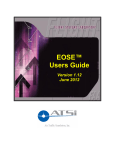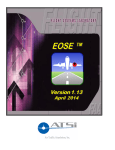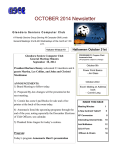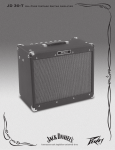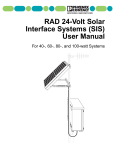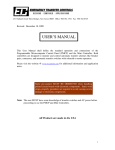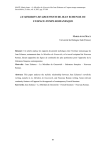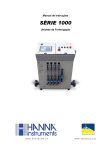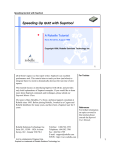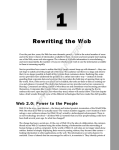Download April 2013 - (AMWA), Northern California Chapter
Transcript
April 2013 AMWA's MISSION is to promote excellence in medical communication and to provide educational resources in support of that goal. Newsletter of the Northern California Chapter of the American Medical Writers Association In THIS ISSUE Letter from the President . . . . . . . . . . 1 Welcome Spring! Defy Your DNA (Chapter Presentation). . . . . . . 2 President's Address Working with ESL Authors: My First Experience as an AMWA Panel Member . . . . . . . . . . . 3 Language Rules!. . . . . 4 The Word Witch . . . . 5 Upcoming Events . . . 6 The Jobs List . . . . . . . 8 Recent Guidance Documents Issued by the FDA . . . . . . . . . . . 8 List of Board of Directors. . . . . . . . . . . 9 Happy spring, fellow AMWA members! It is April, and I recently finished the Chapter report to the AMWA National Board of Director’s meeting. In this report, I describe our chapter activities since the National Conference in Sacramento last fall. We routinely organize quarterly face-toface chapter meetings on a weekend day. They alternate between “learn-a-skill” events and discussions with an experts or authors who write about scientific or medical subjects. We traditionally have a networking social in the late summer. Sometimes we go to a cultural event such as a movie, play, or museum show that relates to science, medicine, or health care. Recently, we tested webinar formats as another way to provide interactive events to our chapter members. In addition to the educational and networking chapter events at venues around the San Francisco Bay Area, there are other opportunities to participate in our chapter. We communicate with Chapter members through different media. We share upcoming events and news via our newsletter Pacemaker, through the skill of our current editor, Caren Rickhoff. We send announcements through our member e-mail list; postings to our LinkedIn Group, administered by Sharon Kim; and notices on our website www.ncalamwa.org, which was recently modernized and updated, and has been maintained by Mimi Wessling. Arushi Sinha administers our chapter job list, which provides interested members with information about medical writing job opportunities via e-mail; members can sign up through the website. Some of our members volunteer to support AMWA National Committees: Nancy Katz is helping with the certification test; Maggie Norris is working on the Chapter Bylaw Committee; Sharon Kim participates on the Social Networking Committee; and I am on the Nominating Committee. If you would like to become more involved in our Northern California Chapter activities, you will find many opportunities. Here are a few: • The Pacific Coast Conference at Asilomar State Beach and Conference Grounds begins April 28. There you can take classes, attend open sessions, and meet other AMWA members. • You can contribute an article to the Pacemaker; just send it to Caren Rickhoff (newsletter@ amwancal.org). • If you would like to share a skill, participate in a panel discussion, suggest a speaker, or help organize a meeting, contact Catherine Magill, our Program Director. • If you have webpage knowledge, perhaps you could assist Mimi Wessling, our website manager. • We also need people to help organize the Pacific Coast Conference in 2014. Please drop me a note if you would like to volunteer or have programs you would like to see or ideas you would like to work on ([email protected]). Suzanne Canada, President Summary of Chapter Presentation, February 2013 Title: Defy Your DNA Speaker: Stephen Shrewsbury, MD By Caren Rickhoff, BA Stephen B. Shrewsbury is a physician whose 33-year career has taken him from the intimate world of English family practice to the cutting edge of global drug development. Dr. Shrewsbury was formerly Chief Medical Officer at AVI BioPharma (now Sarepta Therapeutics). Dr. Shrewsbury is also publications coordinator for the pan-industry think tank, the Oligonucleotide Safety Working Group. Defy Your DNA: How the New Gene Patch Personalized Medicines Will Help You Overcome Your Greatest Health Challenges In his presentation to the Northern California AMWA Chapter, Dr. Shrewsbury, author of Defy Your DNA, described the future of drug discovery and development after the age of “blockbuster” medicines. As he noted, we humans have 25,000 genes that code for 150,000 proteins; however, the 30,000 drugs developed to date target only 2% of those proteins. Part of the reason so few proteins have been targeted is that 20th century drug development focused on creating medicines to treat diseases that occur in large populations. That approach has run its course without addressing a particularly challenging category of diseases referred to as rare diseases. A rare disease is defined as one that affects fewer than 200,000 Americans. However, taken together, the approximately 7,000 rare diseases that have been characterized (and the roughly 7,000 that have not been) affect 1 in 10 Americans. Some of the more well-known rare diseases include pulmonary fibrosis, multiple sclerosis, hemophilia, Huntington disease, and Duchenne muscular dystrophy. Dr. Shrewsbury described an area of research that offers hope for the development of highly specific drugs that target the genetic machinery that leads to the dysfunctional proteins that cause such diseases. “Gene patch” personalized medicine focuses on the development of small stretches of single-stranded synthetic DNA—oligonucleotides (or oligomers)—that can be used to modify defective genes that code for proteins that cause diseases. By tackling diseases at the gene transcription stage, the gene patch approach allows modification of the message from some mutated genes so that the function of the resulting protein is partially or wholly restored or neutralized and the disease path is thus altered. A critical advantage of oligomer science is that it allows rapid design and development of novel therapeutic candidates, including candidates addressing previously difficult-to-target rare diseases. In addition, the highly specific oligomers appear to have few, if any, “off target” or adverse effects, making this new generation of drugs ideal: effective and safe. That, of course, remains to be proven, but early results are promising. Various oligomers are currently in development to treat diseases such as amyotrophic lateral sclerosis, spinal muscular atrophy, acromegaly, and glioma. In an example of how such drugs are created, Dr. Shrewsbury reviewed the development of eteplirsen (AVI-4658) to treat Duchenne muscular dystrophy (DMD). DMD is an X-linked, rare, degenerative neuromuscular disorder leading to severe, progressive muscle loss and premature death. It is caused by one of many variations in a defective gene for dystrophin, a protein that plays a key structural role in muscle fiber function. Having seen the devastating effects of this disease firsthand, Dr. Shrewsbury was motivated to search for treatments, and he has been intimately involved with eteplirsen research. Designed for people with DMD who have specific deletions in the dystrophin gene, eteplirsen is an example of an an “exon-skipping” drug. That is, by successfully skipping exons that result in out-of-frame, disease-causing mRNA transcription, the drug splices exons together in such a way that in-frame mRNA is formed, which, in turn, results in a milder form of muscular dystrophy. Results of a Phase 2b study were promising in stabilizing the decline in walking ability of patients with DMD, and recently those results were further substantiated in the ongoing open-label, follow-on extension. Dr. Shrewsbury concluded his presentation by describing the doctor’s office of the future and his predictions for the top 10 ways in which medicine will leap forward and transform health care for all in the next generation. It is a promising picture of clinical practice that is less invasive, more effective, and personalized to individual patient profiles. In this view of future medicine, gene patch therapies are a stepping-stone toward the ultimate goal of gene replacement therapies. For more information about Dr. Shrewsbury and his book: Email: [email protected] Twitter: @SBShrewsbury Facebook page: https://www.facebook.com/DefyYourDnaBook?ref=stream. Book information: http://defyyourdnabook.com/ Page 2 Working with ESL Authors: My First Experience as an AMWA Panel Member One of the most interesting things about participating in AMWA activities—from our local Chapter meetings to the Annual Conference with its extensive menu of wonderful opportunities—is learning how people of diverse backgrounds came to be medical editors and writers. That can also be scary under certain circumstances! By Mimi Wessling Mimi Wessling is a longtime AMWA member who is also our Northern California AMWA Chapter webmaster Scared? Yes, that’s how I felt when I found myself agreeing to be a member of a panel at the Sacramento 2012 Annual Conference. The topic was certainly one in which I’d had a fair amount of experience: “Strategies for Working Successfully with English as a Second Language Authors.” When my Pacific Southwest colleague, Noelle Demas, told me who the other panel members were going to be, I—to use a very novelistic word — blanched. Lee Seaman of the Pacific Northwest Chapter: Lee is fluent in Japanese, has lived and worked in Japan, and now keeps business hours that match those of her Japanese clients. Charles Bedord of our Northern California Chapter: Charles is another person with fantastic credentials, including corporate experience and laboratory experience. And here I am, an escapee from 20 years in academia who found medical writing the ideal way to combine love of medical science with other interests and skills. I’ve worked mainly through agencies, only rarely with individual authors, and have been a professional medical writer for only 10 years. As it turned out, Charles was unable to join us, which made the contrast between my credentials and Lee’s seem even more stark to me. However, as fate would have it, the attendees also had varied backgrounds, and Noelle skillfully facilitated the program to take advantage of the overlap between our careers and to show the rich opportunities for entry and success in the field. Noelle’s a pharmaceutical regulatory writer; her introductory remarks emphasized that working with non-native speakers is an attractive market for AMWA writers, both in editing articles for publication and in regulatory writing. The main part of the session started with a presentation by Lee emphasizing challenges posed by the steps necessary to get materials ready for an FDA presentation when the company involved is oriented differently, both linguistically and culturally. She described the global English concepts given by John R. Kohl’s book, The Global English Style Guide: Writing Clear Translatable Documentation for a Global Market. Lee’s slides were a beautiful way to show the audience the difference between the way a Japanese author thinks and a native English-speaker, in particular an American without much exposure to Japanese culture, thinks. I then talked about my previous work as an academic historian of science and medicine and professional translator of German, and how it eventually led to English as a second language (ESL) editing. In what I thought might be a somewhat risky move, I also went into some detail about the pitfalls of working through agencies, and in particular, about one instance in which I was completely taken advantage of and underpaid. (After the session, one of the attendees thanked me specifically for that information…whew!) The next part of the session was a Question and Answer discussion about ESL work. The questions were culled from 3×5 index cards distributed to each participant. That proved to be an excellent way to see the range of interests and the questions that our presentations had evinced from the attendees. Just as an example, the issues of payments and in what form, and how long the time lag should be between submitting work and receiving payment were major concerns. At the close of the session, individual participants came up to us with more precise questions tailored to our areas of work and expertise. It was both gratifying and annoying that we had underestimated the number of people who would attend a Saturday morning session, and we ran out of printed handouts. We collected email addresses from those who did not receive handouts during the session and sent them copies; this, in turn, led to some gratifying return emails mentioning how helpful the panel discussion had been. Moral of the story: every one of us has something to contribute! Page 3 Language Rules! By Joan Brodovsky, MS, ELS Joan Brodovsky, whose past includes positions as an analytical chemist and a market researcher specialized in the pharmaceutical and device industries, now edits medical research articles, written by nonnative English speakers and destined for peerreviewed journals. She says Winston Churchill taught her to write, fifty-five years ago, and her delight in playing Gotcha! makes her think editing is a lot of fun. She finds it embarrassing that she, herself, cannot write without an external pair of eyes to catch her own bloopers. She has been a member of AMWA since 2003. In this column, I share my delight in the writing gaffes I find in my reading material, and I post tips for writing elegant and understandable sentences. I count on some 15 reference books to back me up, the most important of which are Schaum’s English Grammar, the AMA Manual of Style, and Janis Bell’s Clean, Well-lighted Sentences. Pronoun Agreement From a column on caring for aged parents: “The assumption is that the resident can move around on their own steam and that they can eat without help.” Where was the copy editor? We English speakers have no singular possessive pronoun for the common gender; we must choose among feminine, masculine, and neuter: “his,” “her,” and “its”. My 7th grade English teacher, Miss Leddy, taught us that pronouns must agree with the nouns they replace and that “his” can mean “his” or “her”. So, Mr. Columnist, it’s either/or: either "…on his own steam and that he can eat…” or “…that the residents can move….” Case before Gerunds From a report of a shootout: “Police were investigating reports that the boy had compiled a “hit list” that led to him being suspended from school last year.” This one is tricky. “Being” comes from the verb “to be,” but here “being” is a noun, part of the whole noun phrase “being suspended from school,” and that action belongs to the boy. It is his being suspended. The corrected phrase reads, “…the boy had compiled a “hit list” that led to his being suspended….” I would eliminate the clunkiness by changing the wording, “... the boy had compiled a “hit list” that led to his suspension....” Verb Conjugation From a report on Jerry Brown’s 2013 State of the State address: “California’s …governor filled his State of the State address with…a tapestry of ideas weaved into a political document meant to set the tone for the Capitol in 2013.” This one was easy to catch; the past tense of “weave” is “woven,” right? Well, not always. It can be “weaved” when one refers a policeman who weaved his car to slow traffic on Highway 101, and it can be “weaved” when one refers to the a drunk who weaved on Highway 101, unnerving the drivers around him. In the first case, “weave” is a transitive verb (weaved his car) and in the second, it is intransitive (the drunk himself just weaved.) However, this one really is easy: when one writes about tapestry, the past tense verb is “woven.” Resources: Clean, Well-lighted Sentences, J. Bell, Norton, 2008. English Grammar, 2nd ed., E. Ehrlich and D. Murphy, Schaum’s Outline Series, McGraw Hill, 1991. AMA Manual of Style, 9th ed., Lippincott Williams & Wilkins, 1998. Webster’s New World College Dictionary, 4th ed., M. Agnes, Ed., IDG Page 4 The Word Witch By Maggie Norris Navigating Back From a Hyperlink Target In this tutorial, I show you an easy way to move your cursor back to your previous place in the file after you have followed a hyperlink. At the same time, I show you an even more useful skill: how to add buttons for any commands you choose to the Quick Access toolbar in Word 2007 and 2010. HIDDEN TREASURE Maggie Norris is a long-time member of the Northern California AMWA Chapter and currently serves on the Chapter Board Hyperlinking is a standard feature in complex documents: these files contain hyperlinks in cross-references to headings, tables, and figures, from citations to their matching reference, and others. It’s easy to jump from the link to the target: just click the hyperlink (or Ctrl + click if you have chosen that method in Word Options). But what we usually want is to have a quick look at the target and then go right back to our previous place in the text. Sadly, there is no obvious command for that. * Word does have a command for this purpose, although it’s hidden so well that most users would never find it on their own. I was alerted to its existence in the User Manual for a regulatory publishing product. Even then, I had to go hunting for it. Then when I found it, the command (tool, button, icon) had to be moved to another location before I could use it. I’ll show you where I found it. At the same time, I’ll show you how to add any command to the Quick Access Toolbar. Screenshot 1. The Customize the Quick Access toolbar dialog screen Procedure Open any Word file. Call up the Customize the Quick Access toolbar dialog box: File | Options | Quick Access toolbar. In the left pane near the top, choose All Commands from the drop-down menu in the Choose commands from field. [Refer to Screenshot 1.] Scroll down the list of commands and select Back. Click Add to copy the Back button to the list in the right pane. Click OK to save the change and return to your file. That’s it. You’re done. The Back button will be available from the Quick Access toolbar in all your files. Beyond the Basics Screenshot 2. Quick Access toolbar default settings Screenshot 3. Word Witch’s Quick Access Toolbar The default settings of the Quick Access toolbar are actually pretty lame: it contains only 5 tools, all for commands that can be executed more conveniently from the keyboard. [Refer to Screenshot 2.] If you open the drop-down at the far right of the toolbar, you can click to add any of the commands listed there; but most of these are pretty lame, too. However, using the procedure above, you can add any command you want to the toolbar. Make the Quick Access toolbar really worthy of the premium space it takes up on your screen. In Screenshot 3, you can see the settings I use. First, I used the Remove button to take out Save and the other defaults. Then I added several commands related to tracking and accepting changes. These are available on the Ribbon, of course; but having them available on the toolbar means I don’t have to switch to the Review tab to accept or reject a single tracked change or to add a comment as I write. Then I added some others I like to have convenient access to, including the Back button. * Note that Shift + F5 takes you back to your previous insertion point when you have moved to another place in your document. But Shift + F5 will not take you back after you have followed a hyperlink. Just one of Word’s quirks. Page 5 UPCOMING EVENTS Upcoming Chapter Presentation Title: Word Witch Power User Seminar Speaker: Maggie Norris It’s been about 6 years since the release of Word 2007, with its radically redesigned interface. Most of us have recovered from the shock of seeing the inscrutable ribbon where the old familiar main menu ought to be. We’ve learned to cope with the change, like we always do. Now that we’ve figured out where to find all our favorite basic commands and features in the new version, it may be time to look at some of its advanced features and techniques. On Saturday, May 4, AMWA Northern California members and friends are invited to attend the Word Witch Power User seminar. The Word Witch, aka Maggie, will show you how to personalize your Word 2007 or 2010 installation so it works the way you want it to. We’ll look at advanced techniques for navigating in complex documents and how to use all the functionality built into the reviewing tools. We’ll draw diagrams, work with graphics, insert footnotes and endnotes, and get a firm grip on document fields. We’ll have a look at some of the better user manuals. As writers who have attended previous Word Witch seminars can tell you, attendees won’t be sitting in a darkened room staring at presentation slides. Word Witch seminars are interactive events where we learn Word together. Please join us and bring your questions and your own excruciatingly clever tips and tricks. Speaker: Maggie Norris When: Saturday, May 4, 2013, 11AM – 2PM Where: Delancey Street Restaurant, 600 Embarcadero, San Francisco, CA 94107 Members: $25 Nonmembers: $30 Register at: http://amwancal050413.eventbrite.com If you would like to pay by check please contact Catherine Magill directly ([email protected]) Upcoming Meetings Upcoming Board of Editors in the Life Sciences Exams Page 6 April 28-May 1, 2013 Pacific Regional Conference Pacific Southwest AMWA Chapter Asilomar Conference Grounds , Pacific Grove, California May 3, 2013 Spring Conference Carolinas AMWA Chapter Chapel Hill, North Carolina May 3-6, 2013 Council of Science Editors Annual Meeting Montreal, Quebec,Canada June 1, 2013 Chapter Conference Rocky Mountain AMWA Chapter Westminster, Colorado June 8, 2013 2013 Chapter Symposium Northwest AMWA Chapter Seatle, Washington June 23-27, 2013 Drug Information Association 49th Annual Meeting Boston, Massachusetts November 6-9, 2013 AMWA's 73rd Annual Conference Columbus, Ohio Saturday, May 4, 2013, Montreal, Quebec Location to be announced Associated meeting: Council of Science Editors Register by April 13, 2013 UPCOMING EVENTS (Concluded) Chapter Conferences 2013 AMWA Pacific Coast Conference - April 28 - May 1, 2013 Asilomar, Pacific Grove, California For more details and to access the conference brochure online: http://www.amwa-pacsw.org/events/PCC-2013/Asilomar%20 Brochure_2013.pdf The conference includes the following: Four Workshops • Essential Ethics for Medical Communicators (Cindy Hamilton, PharmD, ELS) • Summarizing Clinical Efficacy Data for a New Drug Application (Peggy Boe, RN) • Business Aspects of a Freelance Career (Cindy Hamilton) • Reporting Randomized Trials in Science Journals (Tom Lang, MA) Seven Open Sessions • Why Would Anyone Want to Hire YOU? How Medical Writers Add Value in Peer-Reviewed Publishing (Tom Lang, MA) • An Introduction to Regulatory Submission Documents (Peggy Boe, RN) • Designing, Developing, and Implementing Continuing Medical Education (Johanna Lackner-Marx, MPH, MSW, CCMEP) • Enhancing Trust in Industry-Sponsored Publications: The Role of the Medical Writer (Kathryn Boorer, PhD) • What’s Different About Regulatory Writing for Biologics? (Aaron Van Etten, MS) • Conducting Effective and Focused Document Review Meetings (Noelle Demas, MS; Robin Weaver, BA) • Technical Tricks to Facilitate Review and Revisions of Large Documents (Susan Chang, PhD) Keynote Session Globalization's Impact on Global Health (Michele Barry, MD, FACP) Forum Career Options in Medical Communications (Sue Hudson, BA, Chair) Rocky Mountain Chapter Conference - 1 June 2013 Butterfly Pavilion in Westminster, Colorado (between Denver and Boulder) For more details and to access the conference brochure online: http://www.amwa-rmc.org/conference/conference.html. The conference includes the following: • Two credit workshops led by Tom Lang—Organizing the Medical Paper and Improving Comprehension: Theories and Research Findings. • Four open sessions—Starting and Building Your Own Freelance Business; Drowning in Information and Starved for Knowledge; Mindmapping; and Be Your Own IT Department. Page 7 The Jobs List Service of the Northern California AMWA Chapter If you are an AMWA Chapter member you know about our Jobs List. We send out notices about job opportunities as we become aware of them. This means the frequency of the jobs notices varies depending on how often the opportunities arise. We make every attempt to keep the Jobs List mailings current with our Chapter membership list. However, please feel free to contact us any time, especially for the following reasons: • You are a Chapter Member and you want to confirm you are on the Jobs List. • You are a Chapter Member and you want to change or modify your contact information. • You have an employment opportunity to share with other Chapter Members. If you have any questions or opportunities to share, please contact Arushi Sinha, Jobs List manager, at [email protected] Recent Guidance Documents Issued by the FDA Documents issued during the last quarter Page 8 Category Title Drug Safety Providing Postmarket Periodic Safety Reports in the ICH E2C(R2) Format (Periodic Benefit-Risk Evaluation Report) Labeling Pediatric Information Incorporated Into Human Prescription Drug and Biological Products Labeling Good Review Practice International Conference on Harmonisation - Multidisciplinary M3(R2)Nonclinical Safety Studies for the Conduct of Human Clinical Trials and Marketing Authorization for Pharmaceuticals: Questions and Answers Clinical/Antimicrobial Antiviral Product Development — Conducting and Submitting Virology Studies to the Agency Guidance for Submitting HCV Resistance Data -Attachment to Guidance Labeling Labeling for Human Prescription Drug and Biological Products - Implementing the PLR Content and Format Requirements Clinical/Medical Alzheimer’s Disease: Developing Drugs for the Treatment of Early Stage Disease International Conference on Harmonisation - Safety S10 Photosafety Evaluation of Pharmaceuticals Clinical Pharmacology Clinical Pharmacogenomics: Premarket Evaluation in Early-Phase Clinical Studies and Recommendations for Labeling International Conference on Harmonisation - Efficacy E3 Structure and Content of Clinical Study Reports - Questions and Answers (R1) Electronic Submissions Providing Regulatory Submissions in Electronic Format — Certain Human Pharmaceutical Product Applications and Related Submissions Using the eCTD Specifications Clinical/Medical Abuse-Deterrent Opioids-Evaluation and Labeling Improving the quality of writing actually improves the quality of thought. Board of Directors, 2012-2013 George Gopen and Judith Swan. The Science of Scientific Writing. American Scientist, NovemberDecember 1990. Nonelected Positions President: Suzanne Canada Vice-President/President-Elect: Maggie Norris Treasurer: Ruth Linden Secretary: Joan Brodovsky Membership Liaison: Kristen Mayo Program Chair: Catherine Magill Newsletter Editor: Caren Rickhoff Web Administrator: Mimi Wessling Immediate Past President: Nancy Katz [email protected] [email protected] [email protected] [email protected] [email protected] [email protected] [email protected] [email protected] [email protected] Contribute to the Pacemaker Northern California AMWA Chapter Members We need your input! • Have you attended a great conference session? • Do you know of a terrific book that all medical writers should be aware of? • Would you like to share knowledge on a particular medical topic? • Do have super tips about software that we writers use? • Have you heard of great podcasts that we should know about? • Do you want to share a humorous anecdote about life as a medical writer? These are just a few of the topics that we want to hear about. If you have something to share with your colleagues or suggestions for the Pacemaker, please send them to the editor of the Pacemaker at [email protected]. Being featured in the Pacemaker impresses your colleagues, bolsters your credentials, and makes you feel good all over. Thank you! Caren Harper Rickhoff Editor, Pacemaker Page 9









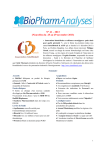
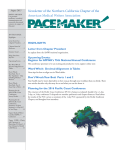
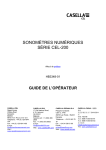


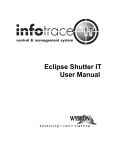

![[(UPDATED!!)] Best - Denon HEOS 7 Wireless Speaker Review](http://vs1.manualzilla.com/store/data/007315054_1-0cd20477453f6073261b7101a03d5a81-150x150.png)

